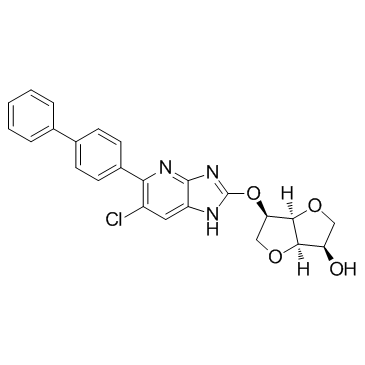MK8722 |
| Catalog No.GC31470 |
MK8722 is a potent and systemic pan-AMPK activator.
Products are for research use only. Not for human use. We do not sell to patients.

Cas No.: 1394371-71-1
Sample solution is provided at 25 µL, 10mM.
MK8722 is a potent and systemic pan-AMPK activator.
MK8722 (MK-8722) is a potent, direct, allosteric activator of all 12 mammalian AMPK complexes. MK8722 activates pAMPK complexes with increased potency and magnitude versus AMP, with EC50 values of ~1 to 60 nM and increased activation by factors of ~4 to 24. Although MK8722 exhibits higher affinity for β1-containing (~1 to 6 nM) versus β2-containing (~15 to 63 nM) pAMPK complexes, it is the most potent activator of β2 complexes reported to date. pAMPK activation by maximal AMP plus MK8722 is synergistic, demonstrating that the agents act at distinct sites[1].
Chronic antihyperglycemic efficacy of MK8722 (MK-8722) is evaluated in db/db mice, a leptin receptor-deficient T2DM model. Once-daily administration of MK8722 results in dose-dependent lowering of ambient blood glucose. On treatment day 12, glucose reductions after MK8722 treatment (30 mpk/day) are comparable to those observed with the PPARγ agonist rosiglitazone (3 mpk/day). Unlike Rosiglitazone, the glucose-lowering action of MK8722 manifests without significant effects on body weight, which is a consistent finding. Dose-dependent increases in tissue pACC are maintained throughout the dosing period. Chronic efficacy, without tachyphylaxis, is also observed in additional dysmetabolic and diabetic rodent models. In all cases, efficacy is associated with trough MK8722 plasma levels comparable to the concentrations required to acutely stimulate skeletal muscle glucose uptake. Chronic MK8722 dosing in mice also increases muscle Glut4 protein levels, possibly contributing to efficacy[1].
[1]. Myers RW, et al. Systemic pan-AMPK activator MK-8722 improves glucose homeostasis but induces cardiachypertrophy. Science. 2017 Aug 4;357(6350):507-511.
Average Rating: 5 (Based on Reviews and 13 reference(s) in Google Scholar.)
GLPBIO products are for RESEARCH USE ONLY. Please make sure your review or question is research based.
Required fields are marked with *




















